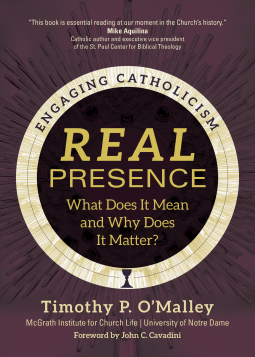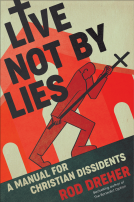
Real Presence
What Does It Mean and Why Does It Matter?
by Timothy P. O'Malley
This title was previously available on NetGalley and is now archived.
Send NetGalley books directly to your Kindle or Kindle app
1
To read on a Kindle or Kindle app, please add kindle@netgalley.com as an approved email address to receive files in your Amazon account. Click here for step-by-step instructions.
2
Also find your Kindle email address within your Amazon account, and enter it here.
Pub Date Mar 12 2021 | Archive Date Jul 15 2022
Talking about this book? Use #RealPresence #NetGalley. More hashtag tips!
Description
What does it mean to consume the Body and Blood of Christ at Mass? Is the Eucharist just a symbol? Is Christ present in the same way he was to the disciples in the upper room?
If you are not sure how to answer these questions about this central mystery of our faith, you aren’t alone—most Catholics don’t. In Real Presence, University of Notre Dame theologian Timothy P. O’Malley clears up the confusion by explaining the biblical origins and long tradition of the Church’s doctrines of real presence and transubstantiation. He also explores the spiritual practices necessary to form us to recognize Christ in the Eucharist and to see the Lord in others.
You will learn
● how the doctrine of real presence is rooted in divine revelation and how the Church’s teaching regarding transubstantiation is spiritually fruitful for the believer today;
● how to worship Christ in the Eucharist and make a real assent to real presence;
● how the Eucharist is crucial in growing our capacity for recognizing Christ in the Word and in others; and
● the important relationship between Eucharistic communion and adoration.
Books in the Engaging Catholicism series from the McGrath Institute for Church Life at the University Notre Dame help readers discover the beauty and truth of the Catholic faith through a concise exploration of the Church’s most important but often difficult-to-grasp doctrines as well as crucial pastoral and spiritual practices. Perfect for seekers and new Catholics; clergy and catechetical leaders; and everyone in between the series, expands the McGrath Institute’s mission to connect the Catholic intellectual life at Notre Dame to the pastoral life of the Church and the spiritual needs of her people.
A Note From the Publisher
O’Malley earned his bachelor’s degree in theology and philosophy and his master’s degree in liturgical studies from Notre Dame. He earned a doctorate in theology and education at Boston College.
He is the author of several books, including the award-winning Off the Hook, Divine Blessing: Liturgical Formation in the RCIA, Bored Again Catholic, and Liturgy and the New Evangelization. His articles have appeared in publications such as America magazine, Religion News Service, Aleteia, Catechist, and Our Sunday Visitor Newsweekly.
The McGrath Institute for Church Life was founded as the Center for Pastoral and Social Ministry by the late Notre Dame President Fr. Theodore Hesburgh, C.S.C., in 1976. The McGrath Institute partners with Catholic dioceses, parishes, and schools to provide theological education and formation to address pressing pastoral problems. The Institute connects the Catholic intellectual life to the life of the Church to form faithful Catholic leaders for service to the Church and the world. The McGrath Institute strives to be the preeminent source of creative Catholic content and programming for the new evangelization.
Advance Praise
“Tim O’Malley is that great rarity—a theologian who’s a joy for ordinary Catholics to read. He’s deep. He’s grounded in family life. He’s a careful observer of human behavior. And he’s funny. This book is essential reading at our moment in the Church’s history. We have failed to communicate the most important thing in life, the mystery of Christ present in the Eucharist—something our ancestors managed to pass on without the extraordinary advantages we have today. O’Malley sees the problem with extraordinary clarity and proposes very practical ways forward. Without an approach like this, our efforts at a new evangelization will be futile. With such an approach—and the grace of God—our prospects are excellent.”
Mike Aquilina
Catholic author and executive vice president of the St. Paul Center for Biblical Theology
"Experiencing God’s presence, not simply knowing the facts of Church teaching, is essential if we are to guide others to discover the gift of Christ’s real presence in the Eucharist. In this concise and excellent book, Timothy P. O’Malley helps us recover an integrated understanding of real presence. Once again, he has woven the academic and pastoral world beautifully. The work of the McGrath Institute is phenomenal!"
Ximena DeBroeck
Director of the Division of Catechetical and Pastoral Formation
Archdiocese of Baltimore
Available Editions
| EDITION | Paperback |
| ISBN | 9781646800551 |
| PRICE | $14.95 (USD) |
Featured Reviews
 Janet P, Reviewer
Janet P, Reviewer
For the last 50+ years, Catholic catechetical education has been sorely lacking. A huge majority of Catholics do not know what transubstantiation means & it is one of the fundamental dogmas of Catholicism.
Cudos to Notre Dame and Ave Maria Press for working to rectify this with new book series on fundamental topics in Catholicism and in Catholic history. These books are short, .orthodox, and very accessible.
Real Presence deals with an important topic in a thorough way, even making the writings of Augustine and Aquinas easy to understand. The book shows us in five chapters the Biblical basis of transubstantiation and the real presence, what the Church Fathers wrote about it, and the very practical advice of medieval and modern women on Eucharist Adoration.
The longest chapter in the book is a thorough analysis of Aquinas' Corpus Christi hymn, Laudo Sion. Through this wonderful analysis, which includes recaps of parts of the saint's important works, the entire theology of the Real Presence is made clear.
I learned so much from this book!
In 2019, a Pew Research Center study on the religious commitment and practice of American Catholics found a significant number of the faith did not have an accurate or complete understanding of the "Real Presence" of Christ in the Eucharist Sacrament. This prompted Cardinal Seán O’Malley of the Archdiocese of Boston to proclaim a "Year of the Eucharist" for 2020-2021 to help rehabilitate the faithful. The "Real Presence" by Dr. Timothy O'Malley could very well be required reading in support of that endeavor. Chapter One tackles the "Obstacles to Real Presence" by identifying three (3) points of confusion: an over-reliance on a physical interpretation of presence, a lack of reverence and an apparent false dichotomy between reverence and recognition of Christ's presence in others. Along the way, Fr. Thomas Reese S.J. is thrown under the bus for declaring that he "find[s] the theology of transubstantiation to be unintelligible" and that we should just "accept it as a mystery and not pretend we understand it." Unfortunately if we do that, I think that we take away some of the power that particular sacrament is supposed to have.
Chapter Two looks at the Real Presence in the Scriptures. Here is where Dr. O'Malley really shines because he focuses on what we mean by presence. After that we move on to Chapter Three to examine how the early Church Father's developed the "doctrine of Eucharistic presence" where the terms Body and Blood are associated to the Bread and Wine. The language used by the early Fathers is not easily understood here and I think this is where most readers start to fall away. While I can acknowledge the mystagogical element to the real presence, my modern mind has trouble with the constant use of Body and Blood when I do not see an actual body or blood. Why must these be linked in the Eucharist? What do we mean when we say Body? Can we explain that term other than symbolically if we don't actually have [what we normally view as] a physical body?
Chapter Four - Savoring the Mystery of Transubstantiation, attempts to answer these questions. After spending a little time with a couple of quarreling monks to define the argument as reality vs symbolic, Dr. O'Malley spends the reminder looking at St. Thomas Aquinas ... an amazing doctor of the church whose theology builds upon the concepts of substance and accidents decried by the afore mentioned Fr. Reese when he states that he does not "believe in prime matter, substantial forms, substance and accidents." Ultimately we get little here other than the belief that the bread and wine are transubstantiated into the true Body and Blood of Christ because the Church says so. Score one for Fr. Reese.
Chapter Five - Eucharistic Devotion and Real Presence, doesn't really add much to the debate, but it does offer a look at how the [various] practices of adoration can enable us to recognize the Real Presence in the Eucharist. While this was not the slam dunk that I was looking for, it does give my plenty to meditate on ... YMMV
I was given this free advance reader copy (ARC) ebook at my request and have voluntarily left this review.
#RealPresence #NetGalley #YearoftheEucharist
 Reviewer 597704
Reviewer 597704
I truly enjoyed Timothy O'Malley's book, Real Presence. As a Catholic revert who is re-learning the faith, O'Malley gave clear and in-depth explanations for the presence of Christ in the Eucharist. I especially liked the connections he drew to the manna in the desert from the book of Exodus and the writings of the early Church Fathers on the Eucharist. It made the New Testament teachings hold more meaning for me. And I am looking forward to going to Mass, knowing all I have available to me in the Bread and Wine.
 Billy K, Reviewer
Billy K, Reviewer
I’ll be honest. I’ve struggled to find a good book on the Catholic belief in the real presence of Jesus Christ in the Eucharist. The books with the most comprehensive approach tend to be so academically focused that they are difficult for the average reader to approach while those written for popular audiences tend to fall into some common traps.
Some of these books reduce the theology to a rigidly formulaic approach – relying on an Aristotelian cosmology which no longer connects with contemporary worldviews. Others express a mystical richness and beauty but offer little concrete scaffolding upon which a substantive understanding can be built. Few touch on the historical development of the doctrine in any significant way which disconnects the theology from the context in which it was developed.
Real Presence by Timothy P. O’Malley is a popular-level book on the doctrine that manages to successfully navigate all the above-mentioned issues masterfully. He helps the reader understand the landscape biblically, historically, and theologically in a way that has practical relevance. He preserves love and appreciation for terms like “Transubstantiation” while acknowledging the real challenges associated with creating meaning around the underlying categories which in a post-Aristotelian world.
Perhaps most importantly, O’Malley manages to make the subject joyful and fun to read about.
I will certainly be recommending this volume to many. For those new to the study of sacramental theology, it’s a primer without rival on the doctrine of Real Presence.







